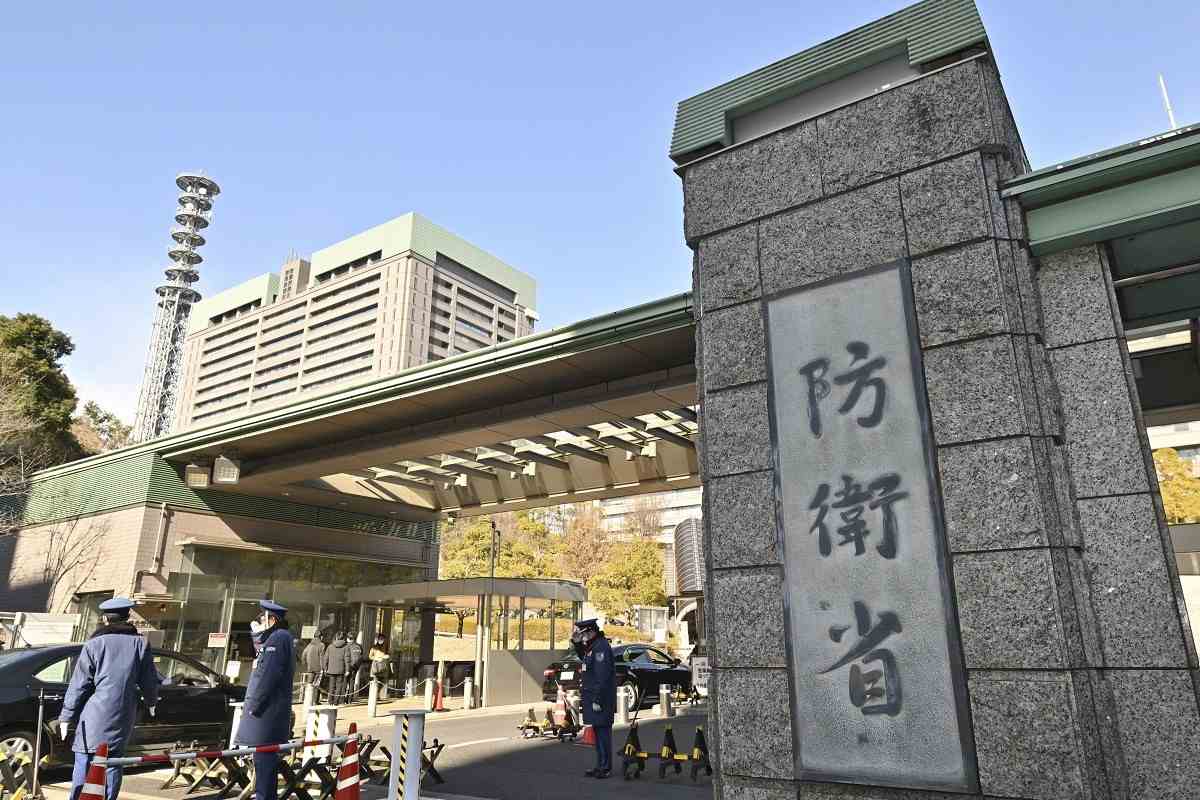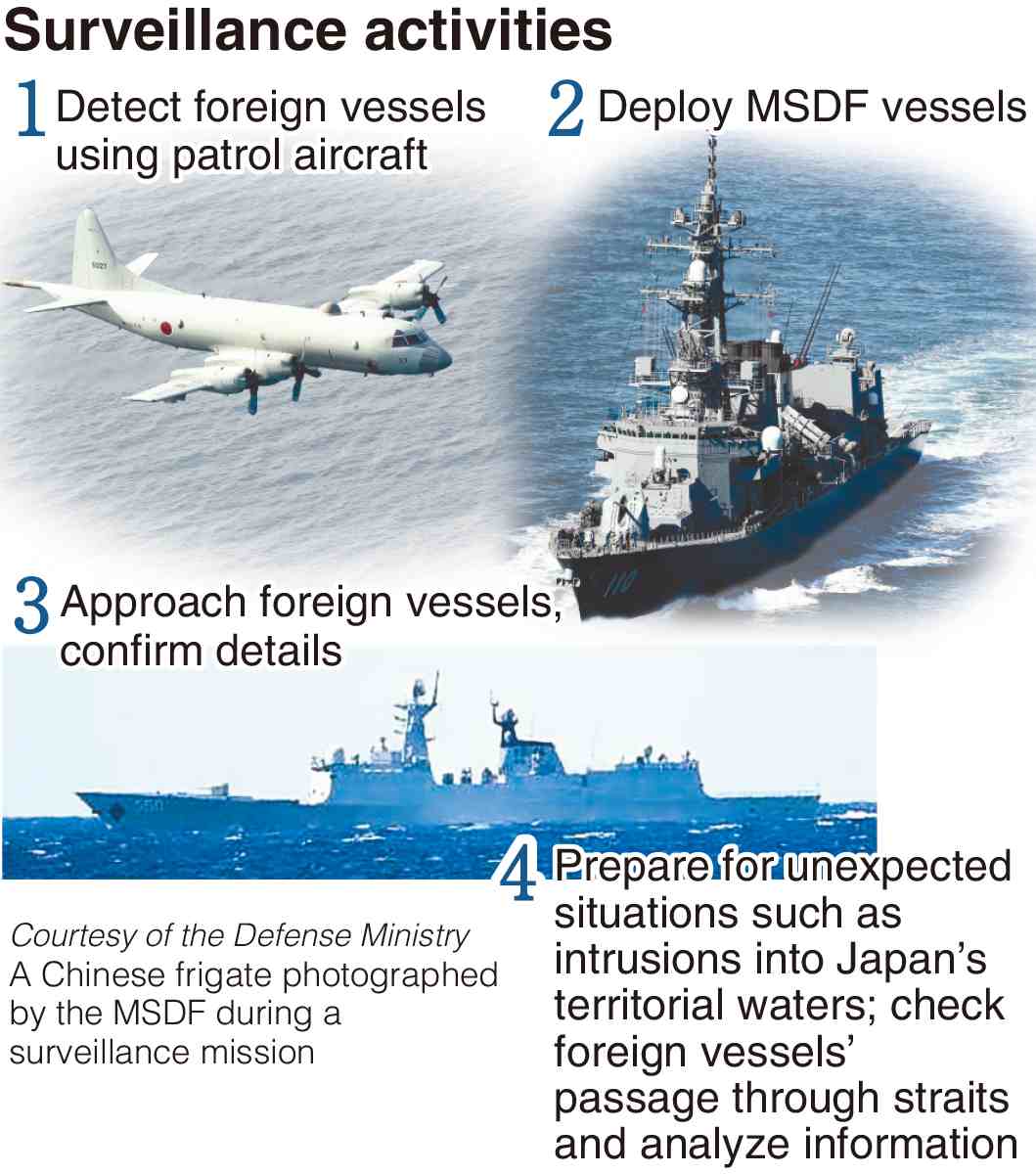
The main gate of the Defense Ministry is seen in Shinjuku Ward, Tokyo.
7:00 JST, November 7, 2023
The Maritime Self-Defense Force is finding it increasingly difficult to monitor the movements of foreign naval ships around the nation’s coasts from small vessels. As a result, some MSDF personnel are reportedly anxious about the possibility of unexpected situations arising.

Possible shortfalls
“I wonder if we can keep up with that ship if it moves unexpectedly,” an MSDF member recalls thinking while monitoring a Chinese ship in the East China Sea while aboard a small MSDF vessel.
As a part of the MSDF’s duties, foreign naval vessels must be prevented from encroaching upon Japan’s territorial waters. However, the officer realized it would be difficult to match the superior speed of the larger Chinese ship. “Smaller vessels have fewer weapons,” the officer noted. “So, our approach at the time was to observe the situation quietly and maintain a certain distance from the Chinese vessel.”
A former MSDF officer who worked on a minesweeper said: “Our ship was small and very susceptible to harsh weather. Many crew members were unfamiliar with the ship’s operational and communication procedures. Fuel and food supplies were limited, and it was difficult to track foreign naval ships for a lengthy period.”
Surveillance activities also involve MSDF vessels approaching and photographing foreign vessels. The former MSDF officer recalled an incident in which an MSDF ship was unable to get close to a foreign ship, so the mission was handed over to an MSDF patrol aircraft instead.
Increased burdens
“Up until around 2010, we rarely saw Chinese vessels in the East China Sea,” said Hideki Yuasa, former commander in chief of the Self-Defense Fleet, who until December was responsible for the operation of MSDF vessels, aircraft and submarines. “If a combat vessel is encountered, it’s best for a destroyer to respond, but this is often difficult.”
Destroyers include general-purpose ships loaded with various weapons, as well as aircraft carrier-like vessels and Aegis ships equipped with high-performance radar.
Smaller vessels include minesweepers and boats equipped with guided missiles. Auxiliary vessels include supply ships that provide fuel and ammunition to other vessels, and multipurpose support ships to assist in fire drills.
The MSDF has 50 destroyers, but some are routinely docked for repairs. Additionally, training is necessary for crews to prepare them for possible contingencies.
“Previously, surveillance was conducted between training periods,” Yuasa said. “Now, however, that situation no longer holds true.”
Observers say incidents that occur in the Nansei Islands require difficult decisions to be made.
For example, the waters around Miyako Island in Okinawa Prefecture, a location where Chinese vessels frequently appear, are about 1,000 kilometers from the MSDF’s Sasebo base in Nagasaki Prefecture — the nearest destroyer home port. To reach Miyako Island from the Sasebo base at a normal speed of 12 knots, or 22 kph, would take two days one-way, or four days for a round-trip.
“Once a destroyer leaves port, crew members have to stay on board for 24 hours and their burden increases according to repeated deployments,” Yuasa said. “To avoid this, we have to rely on small and auxiliary vessels.”
Data released by the Joint Staff Office has focused on cases in which Chinese and Russian vessels have sailed through key areas in waters around Japan. Surveillance, however, is conducted across a wider area. Patrol aircraft are used to increase efficiency, but operations are increasingly being strained by an uptick in the number of missions that only destroyers can deal with, such as responding to North Korean ballistic missiles, fighting piracy off the coast of Somalia and participation in multinational drills overseas.
New ideas needed
China has been conducting regular exercises in the Pacific Ocean to counter the United States. Russia, meanwhile, has been demonstrating its power in the Far East. In 2022 and 2023, Chinese and Russian vessels circumnavigated Japan to demonstrate their capabilities.
Yasuhiro Kawakami, a former rear admiral and director of Security Studies Program at the Sasakawa Peace Foundation, said: “The number of Chinese naval vessels is likely to increase in the future as Beijing’s defense spending continues to grow. The MSDF must generate new ideas, such as installing small unmanned aerial vehicles on new FFM frigates to ensure efficient surveillance.”
“China is likely to have learned about Japan’s limitations after noting the deployment of small and auxiliary vessels for surveillance,” Kawakami added. “It’s necessary to deal with this situation immediately.”
"Politics" POPULAR ARTICLE
-

Japan to Support Central Asian Logistics Route That Bypasses Russia, Plan to Be Part of Upcoming Summit in Tokyo
-

Japan to Tighten Screening of Foreigners’ Residential Status by Providing Information of Nonpayment of Taxes
-

Chinese, Russian Bombers Flew Unusual Path by Heading Toward Tokyo; Move Likely Meant to Intimidate Japan
-

Japan Plans National Database to Track Foreign Ownership of Real Estate, Land as It Weighs New Rules
-

Up to 199,000 Deaths Estimated From Mega-Tsunami; Most Recent Occurrence Took Place in 17th Century
JN ACCESS RANKING
-

Keidanren Chairman Yoshinobu Tsutsui Visits Kashiwazaki-Kariwa Nuclear Power Plant; Inspects New Emergency Safety System
-

Tokyo Economic Security Forum to Hold Inaugural Meeting Amid Tense Global Environment
-

Imports of Rare Earths from China Facing Delays, May Be Caused by Deterioration of Japan-China Relations
-

University of Tokyo Professor Discusses Japanese Economic Security in Interview Ahead of Forum
-

Japan Pulls out of Vietnam Nuclear Project, Complicating Hanoi’s Power Plans
























